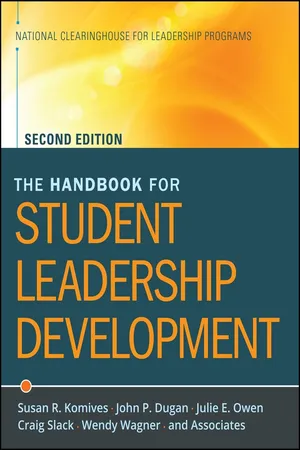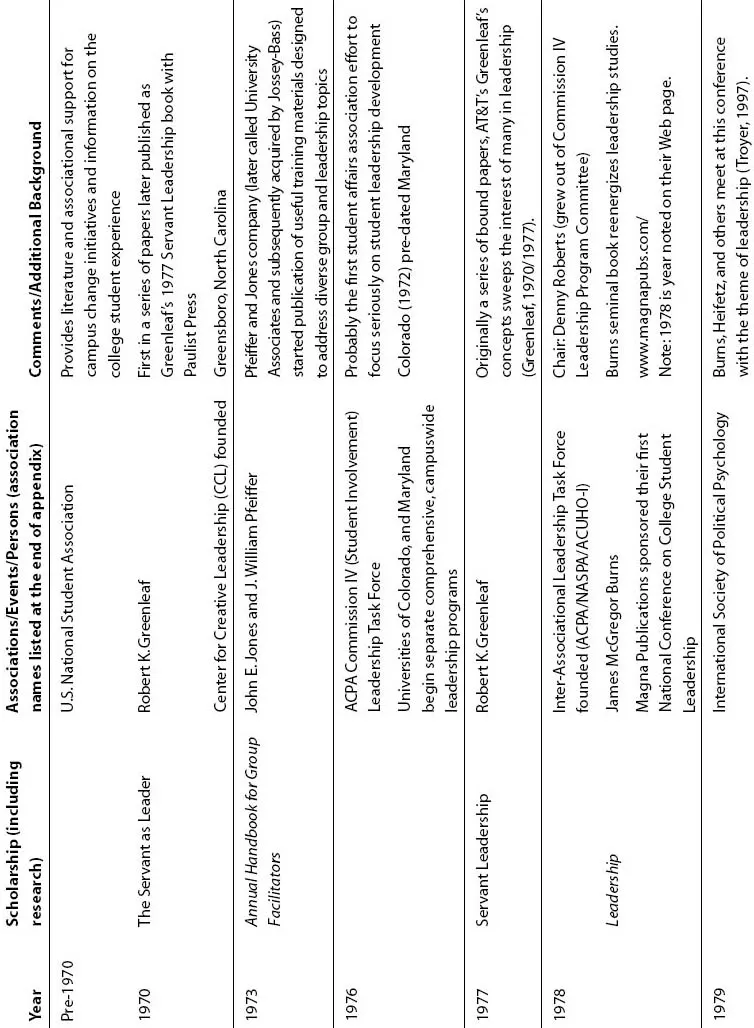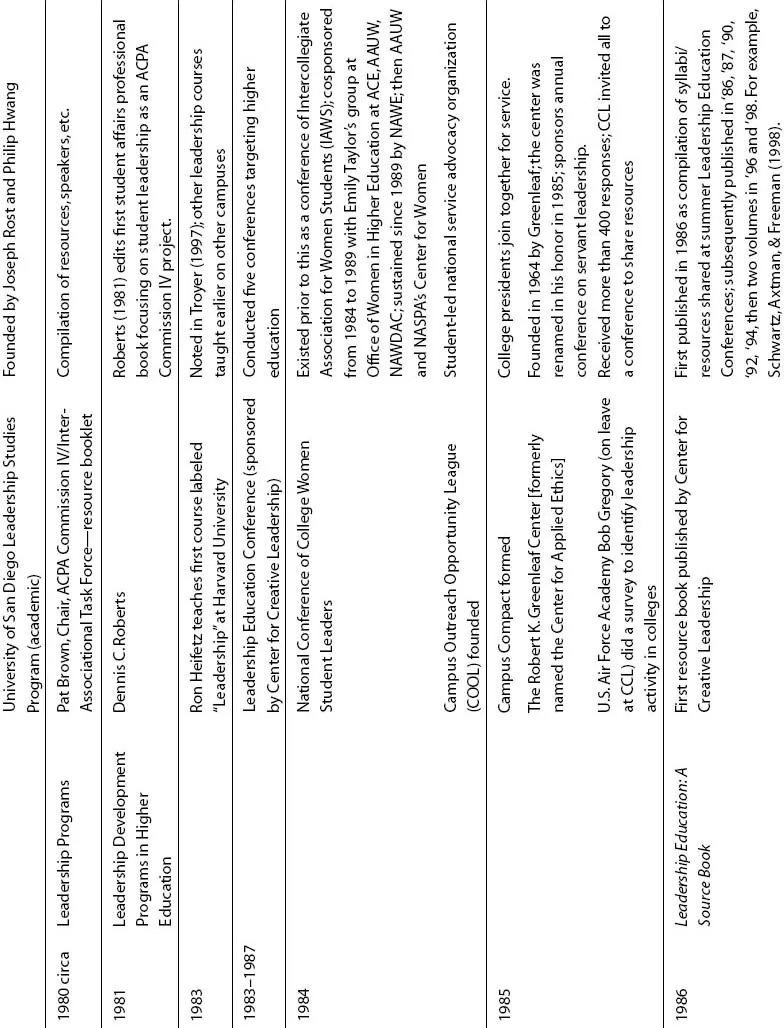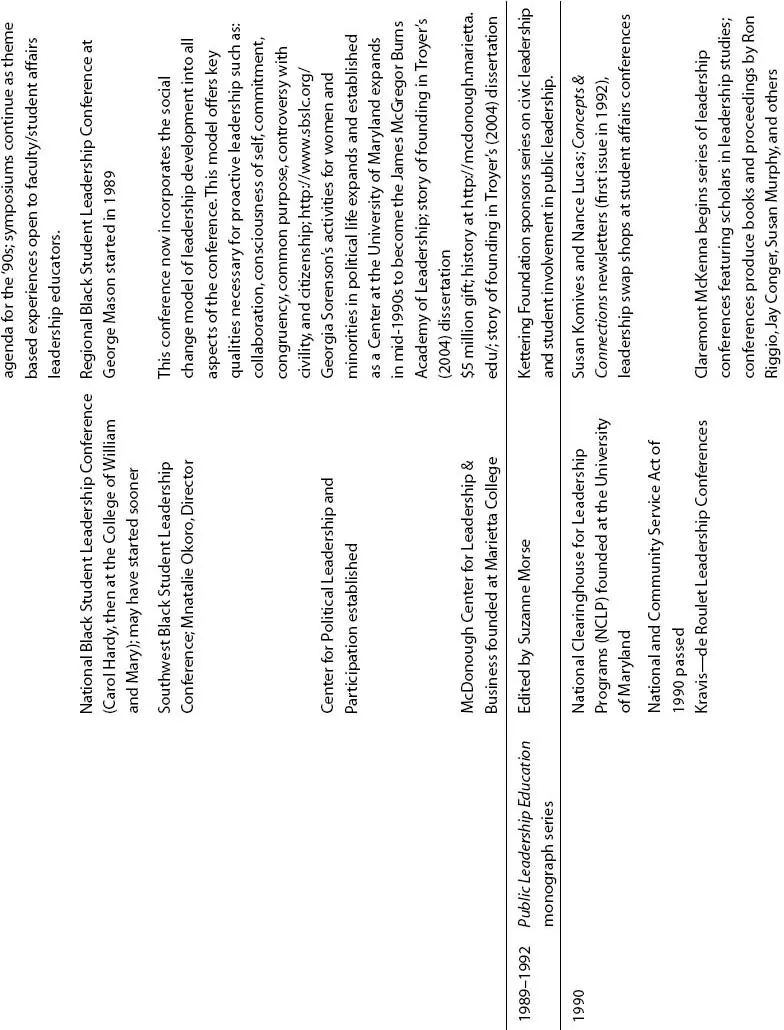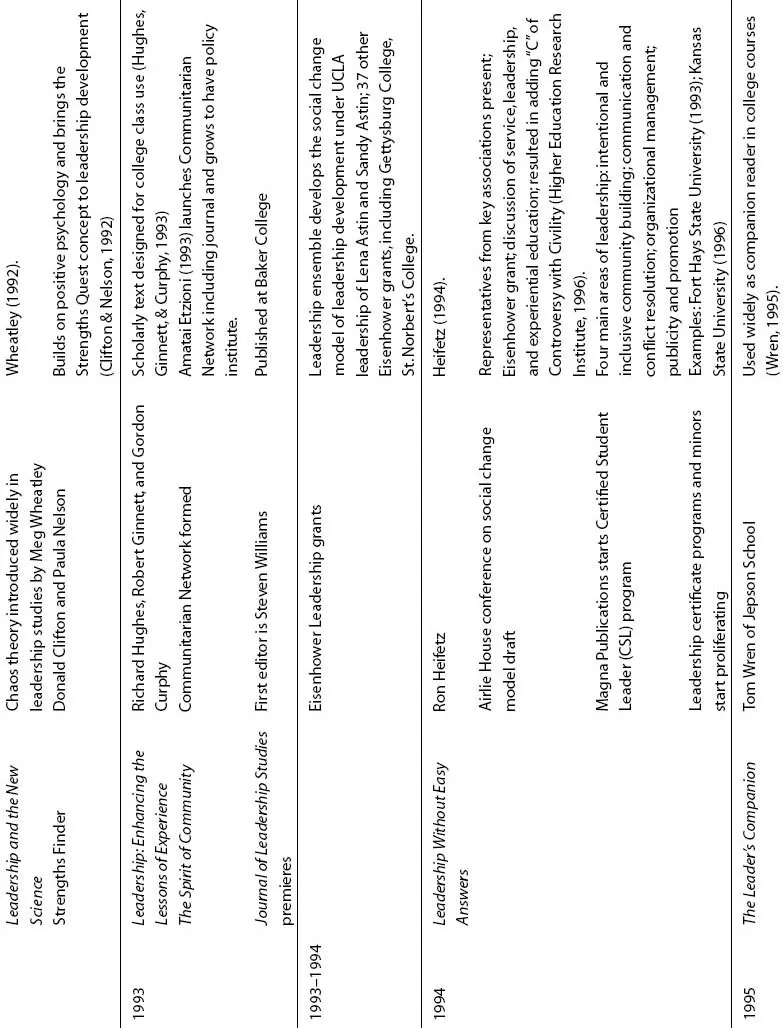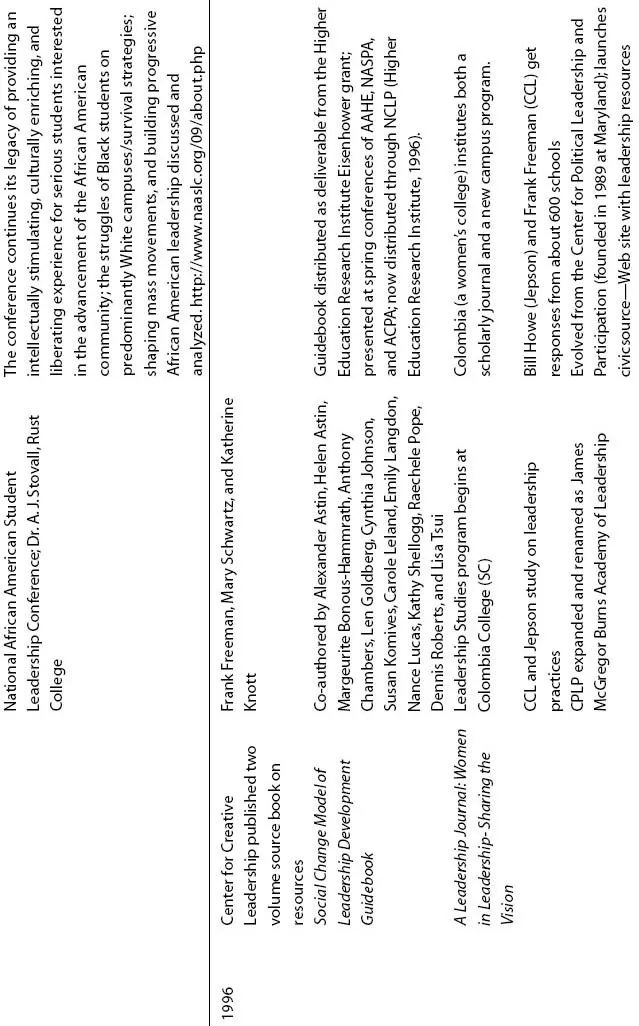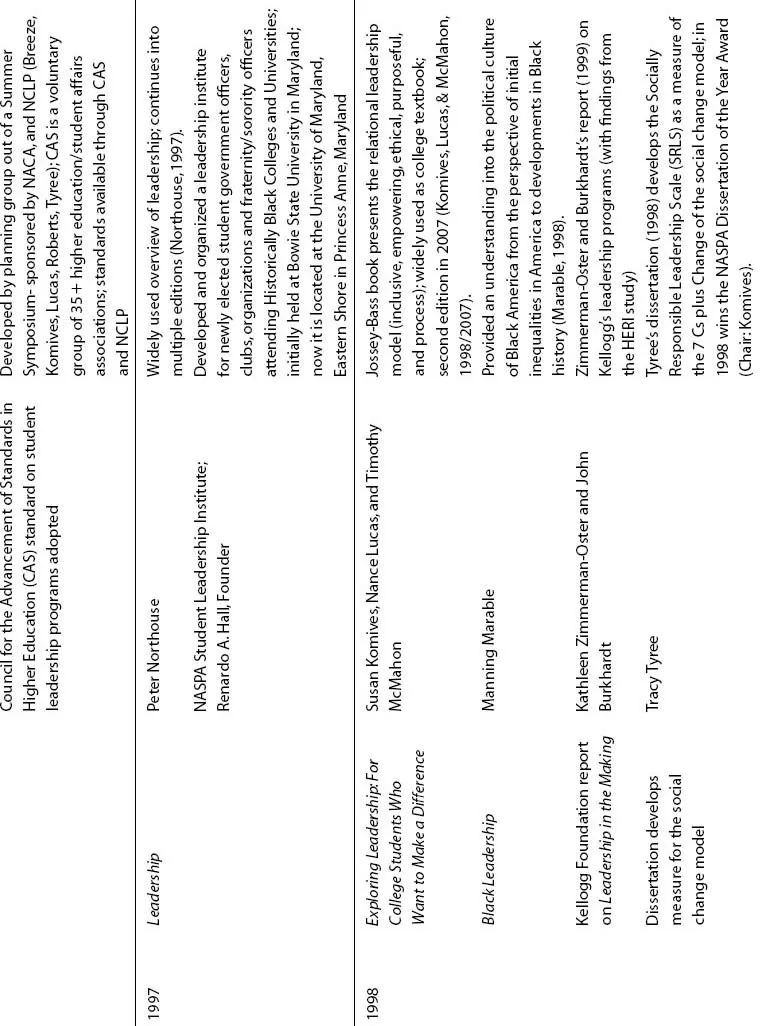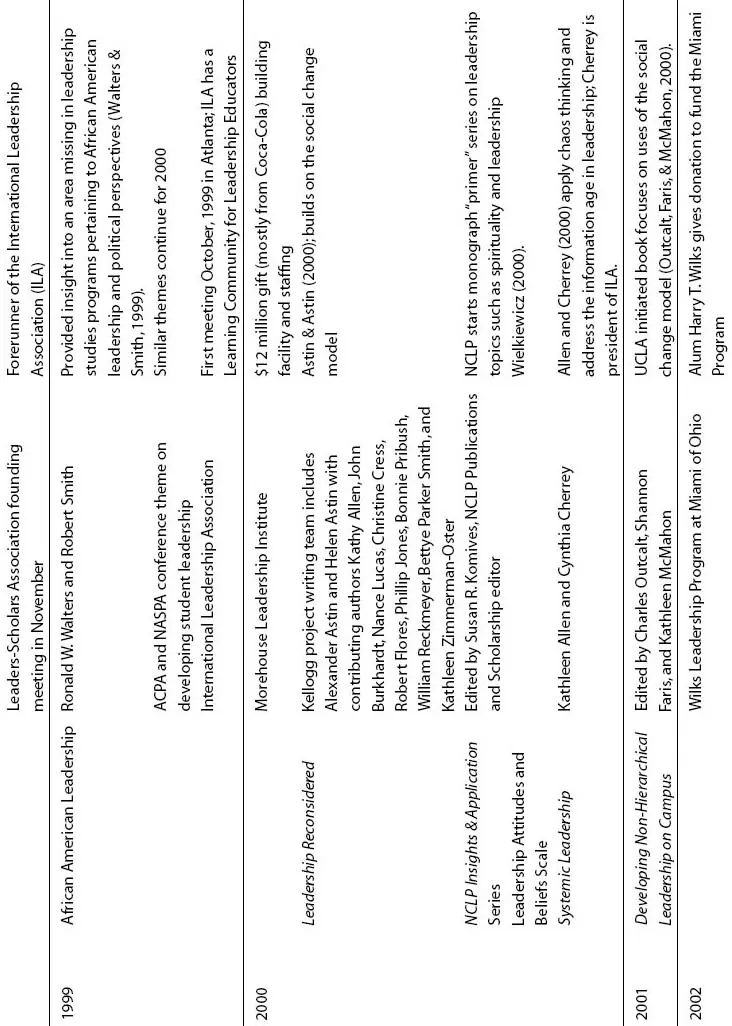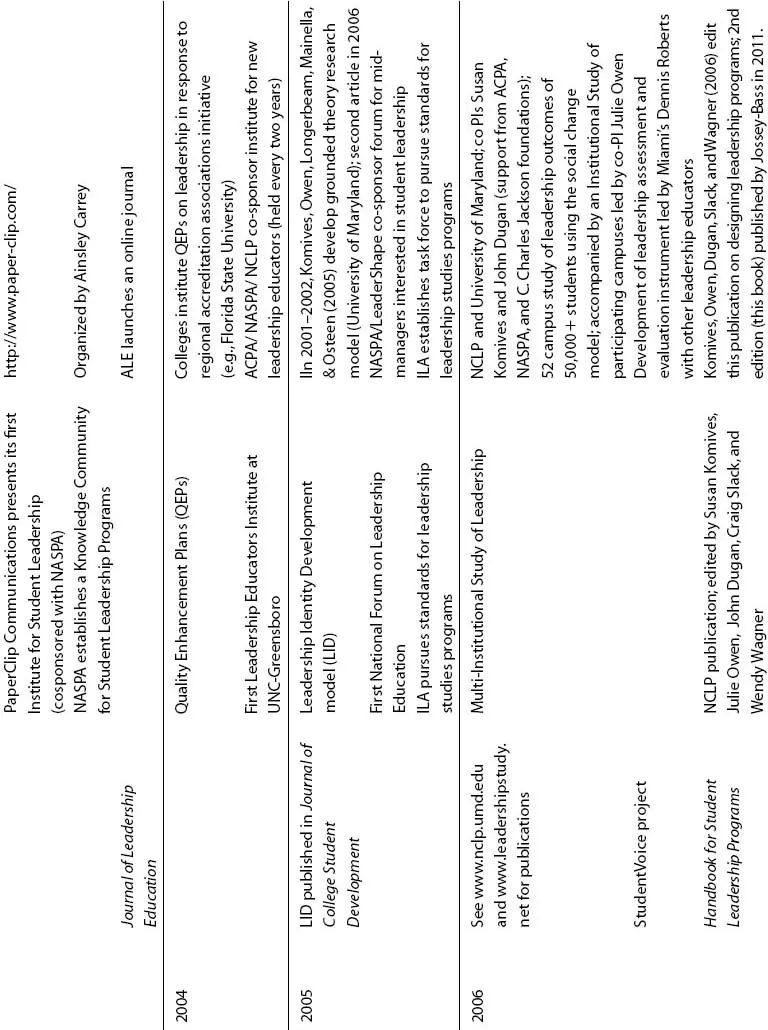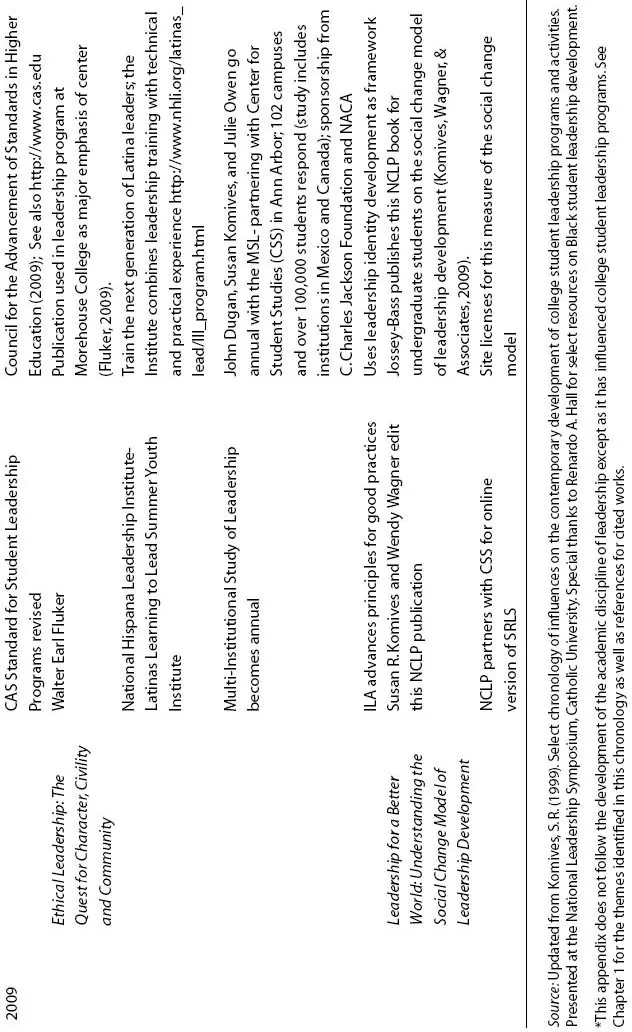![]()
Chapter 1
Advancing Leadership Education
Susan R. Komives
Since my first year in higher education more than 45 years ago, I have been fascinated by student leadership development. As an undergraduate positional student leader at Florida State University, I became aware of what I would now call my “leadership identity.” As a new professional at the University of Tennessee, I wove leadership into my resident assistant training course in 1970. It was also at the University of Tennessee that—following the maxim that one’s scholarship is largely autobiographical—my dissertation in 1973 was on leadership. Concurrently, as a young woman professional when the glass ceiling was cracking, I gained tremendous affirmation from numerous professional sessions focused on women’s leadership and career advancement. Gender attributions and difference in leadership fascinated me! Subsequently, at Denison University a colleague and I designed an undergraduate leadership course in 1974 and started offering student leadership workshops, often in trade with colleagues at nearby universities for programs they would do on my campus.
In those early years, Greenleaf’s (1970/1991) servant leadership work came to me as an underground movement. Copies of Greenleaf’s papers and those by such thinkers as Kathy Allen and Parker Palmer were typed on stencils or dittoes, passed around among friends as “must-reads,” and then photocopied so many times they became illegible. Those of us passionate about leadership began finding each other at conferences sponsored by associations like the American College Personnel Association (ACPA), and longtime colleague Denny Roberts and others began coalescing around a movement to focus professionally on college student leadership development. It is truly exciting to see the evolution of these efforts over the years and the many threads that have woven the rich and thick leadership education tapestry we find today.
This chapter sets the context of college student leadership development in higher education by tracing select historical developments and recent trends that have enhanced the field of leadership education. It identifies current issues and needs in leadership education, focusing on college student leadership programs. As noted in the Preface, the focus of this Handbook is on college programs, with a specific emphasis on programs in student affairs. Our thesis is that all leadership educators are responsible for this shared journey of advancing the college student leadership agenda, and readers can situate themselves in areas that need their attention, pique their interests, and use their talents.
Professionalization of Leadership Education
Over the past 30 years, leadership education has evolved from a fragmented set of atheoretical (even antitheoretical), uncoordinated activities with little common language or practices to a field with established theoretical frames, conceptual models, standards of practice, and diverse pedagogical strategies. The field has a body of scholarship, emergent assessment and research, and support systems for practitioners such as professional associations and graduate preparation courses, all evidencing a student-centered focus incorporating and responsive to student diversity (Astin & Astin, 2000; Brungardt, 1996; Cress, Astin, Zimmerman-Oster, & Burkhardt, 2001; Dugan & Komives, 2007; Komives, Dugan, Owen, Slack, & Wagner, 2006; Komives, Longerbeam, Mainella, Osteen, Owen, & Wagner, 2009). The emergent professionalism in the field is encouraging.
Themes in the Development of Leadership Education
The history of leadership education is intertwined with the evolution of leadership studies. This analysis includes select initiatives in leadership studies that propelled the development of leadership education. The analysis that follows benefited from observers of this evolution, including Georgia Sorenson’s (2000) analysis of the leadership studies history with an emphasis on the role of James MacGregor Burns; Mark Troyer’s (1997, 2004) reviews of the field and case studies of several leadership curricular centers; and Renardo Hall’s reflections on Black student leadership programs (personal communication, July 27, 2009).
In the mid-1990s, I began to chronicle influences on the development of college student leadership programs (see Appendix 1.1 at the end of this chapter: Select Chronology of Influences on the Contemporary Development of College Student Leadership Programs and Related Activities). From that first analysis it became clear to me that a coalescence of events from the 1980s and early 1990s palpably shaped the field of college leadership education, resulting in impressive depth and breadth. Denny Roberts’s (2007) overview of the evolution of the field of leadership education woven with student affairs philosophies and values provides additional wisdom and insight into this history. Although informed by many colleagues over the years, with my appreciation, the full responsibility for the chapter’s weaknesses is mine, and I acknowledge it is “the-leadership-world-according-to-Susan” and as such brings the frames and lenses I have to making meaning of this evolution.
APPENDIX 1.1: Select Chronology of Influences on the Contemporary Development of College Student Leadership Programs and Related Activities*
The advancing field of leadership education was informed by the evolution of scholarship, the cross-fertilization of interested professionals in association settings, the growing work of clearinghouses, centers, and institutes, and the blossoming and sharing of diverse pedagogies. The sophistication in those elements led to the establishment of standards of practice, the development of theories and models for the college population, assessment measures, and increased scholarly research. Woven through all these elements was a commitment to student-centered practices that advanced the leadership capacity of diverse students working in diverse contexts. Current developments include the emergence of the “student leadership industry” with contributions from publishers, consultants, professional speakers, and private companies that sponsor student leadership institutes, assessment measures, and training institutes.
Although there is one grand narrative interweaving all these elements (as elements became normative, other dimensions emerged and some developed in tandem), this section of the chapter presents some dimensions in the evolution of each theme so that the reader can see one perspective on the growing complexity and depth of the state of the field. Certainly there are many more contributions and facts that can be included; those stated illustrate the evolution of key themes, often highlighting the first or early contributions to the field.
Associations and Their Support
Professional interest in leadership has existed for generations in student affairs work. In 1974, a number of student affairs professionals dedicated to leadership education expanded their work in ACPA and formed the Inter-Associational Task Force on Leadership Development, reaching out to like-minded professionals in such groups as the National Association of Student Personnel Administrators (NASPA), the Association of College and University Housing Officers-International (ACUHO-I), and the National Association of Campus Activities (NACA). The fine work of this group led to many initiatives, such as a leadership development model that differentiated leadership training, education, and development (Roberts & Ullom, 1989), a compilation of leadership resources (see 1980 in the Chapter Appendix), and the first book on student leadership programs (Roberts, 1981).
In 1987, I came to the University of Maryland and with the support of the longtime vice president for student affairs, William “Bud” L. Thomas Jr., scanned the higher education environment, and determined that the field would benefit from a clearinghouse that would organize the growing body of resources and be a lightning rod for advancing networking and the scholarship on leadership education. With the support of other entities such as the Center for Creative Leadership (CCL) and the Task Force (chaired by Nance Lucas), in 1989 the University of Maryland formed the National Clearinghouse for Leadership Programs (NCLP). Lucas came to the University of Maryland and joined me as a cofounder of the NCLP. Concurrently, the Commission on Student Involvement in ACPA continued its interest in leadership, NACA supported similar goals, and in 2002 Ainsley Carry initiated a Knowledge Community for Student Leadership Programs (KCSLP) in NASPA.
On a parallel track, college leadership educators in the agricultural and extension community were re-visioning their youth leadership work and in 1989 founded the Association of Leadership Educators (ALE). The emergence of the International Leadership Association (ILA) in 1998–1999 brought a broad-based group of leadership educators together with leadership faculty and scholars, community leadership activists, and business consultants together in a global context. The Leadership Education Member Interest Group is the largest group within ILA.
Associations provide substantial supports to advance professional work. In addition to the leadership programs at generalist conferences like ACPA and NASPA, the annual conferences for leadership focused-associations like ALE and ILA provide immersion in the best of leadership scholarship and practice. Several associations like ACPA, NACA, and NASPA have joined with NCLP and each other to provide key professional development programs. For example, NACA and NCLP provide the summer, theme-based National Leadership Symposium. In those settings 75–80 leadership educators explore such thematic topics as spirituality and leadership or global leadership with authors of key books and colleagues. Starting in 2004, ACPA, NASPA, and NCLP have cosponsored the popular Leadership Educators Institute that occurs every two years. Other professional development formats have evolved: ILA sponsors webinars, NASPA’s KCSLP sponsors group conference calls, and ACPA has sponsored short-term, online leadership courses. Associations have also advanced standards of practice noted later in this chapter.
Centers, Institutes, and the Leadership Industry
The business world of leadership development is surrounded by a plethora of centers that support the advancement of managerial or organizational leadership. Entities such as the CCL, founded in 1970, ventured into higher education leadership in the early 1980s. CCL sponsored faculty symposia and published compendiums supporting leadership education containing course syllabi and training resources. As a result of CCL’s decision to discontinue their higher education thrust, their popular summer institute shifted to the Jepson School of Leadership Studies in 1994, and CCL sent their database of sample course syllabi to the then-new NCLP. The Center for Applied Ethics, founded in 1964 by Robert Greenleaf, substantially broadened its base and renamed itself the Robert K. Greenleaf Center in 1985 and is now known as the Greenleaf Center for Servant Leadership. Training materials for diverse leadership contexts emerged in the 1980s (e.g., University Associates’ Pfeiffer and Jones materials); specialty centers and materials now exist for churches, the military, youth programs, and community activists along with education and business.
In 1989, Georgia Sorenson established the Center for Political Leadership and Participation at the University of Maryland. The center expanded in 1996 to become the James MacGregor Burns Academy of Leadership to sponsor numerous think tanks with grants from the Kellogg Foundation, substantially advancing leadership studies and establishing the International Leadership Association. Numerous annual institutes emerged in the 1990s, including the Rocky Mountain Leadership Institute and the Kravis Institute at Claremont McKenna, resulting in the annual release of books with papers from those theme-based gatherings.
In the 1980s, a number of organizations began to emphasize leadership for targeted groups of college students. In 1984, the National Association of Women in Education (NAWE) sponsored the National Women Student Leaders conference that was subsequently sponsored by NASPA and the American Association of University Women (AAUW) after NAWE’s closure. Conferences for Black student leaders emerged in the 1980s, including a series of conferences ...
